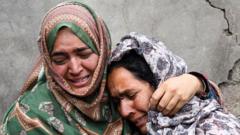Families living along the Line of Control between India and Pakistan face ongoing violence from shelling and military confrontations. Despite attempts at ceasefire and peace agreements, the region remains one of the most volatile borders in the world, with uncertainties threatening the lives of the residents.
The Fragile Landscape of the India-Pakistan Border: A Looming Conflict

The Fragile Landscape of the India-Pakistan Border: A Looming Conflict
The Line of Control (LoC) between India and Pakistan remains a focal point of tension, perpetuated by recent escalations and historical hostilities.
The Line of Control (LoC), the contentious boundary separating India and Pakistan, creates a harrowing existence for those living nearby, caught in the relentless cycle of military aggression and fragile peace. The recent spike in confrontations following the Pahalgam attack has rekindled fears of escalation between the two nuclear-armed nations. Reports indicate that at least 16 fatalities occurred on the Indian side, while Pakistani officials claim casualties as high as 40 among civilians, drawing sharp focus on the human toll of the conflict.
"Life on the LoC is dictated by the unpredictable whims of both nations, leading to devastating outcomes for families," explains Anam Zakaria, a Canadian-based Pakistani author. She emphasizes how conflicts displace families, obliterate livelihoods, and irreparably damage critical infrastructure, like homes and schools.
Stretching over 3,323 kilometers (2,064 miles), India and Pakistan's border, comprising both the LoC and an International Border (IB), has been a major flashpoint since the end of British colonial rule. The origins of the LoC date back to 1949 when it was first established as a Ceasefire Line post the first Indo-Pakistani war, evolving under the 1972 Simla Agreement. The never-ending potential for conflict manifests itself through regular ceasefire violations, where incidents can escalate rapidly from minor skirmishes to full-scale military operations.
Experts describe the LoC as emblematic of "territory forged in conflict," one that reflects the neglect of local sentiments in Kashmir's disputes. According to Sumantra Bose of the London School of Economics, the border's significance is underlined by its grotesque history, mirrored by other global conflict zones seeking resolution through peace treaties and negotiations.
As tensions mounted further with the latest skirmishes, India suspended the Indus Waters Treaty with Pakistan, signaling a reevaluation of long-standing agreements. Pakistan's subsequent warning to reconsider its stance on the Simla Agreement captures the fraught nature of bilateral relations, as both sides grapple with the implications of their actions.
Debate swirls around how the future of the LoC might evolve, with some suggesting formal recognition of the boundary while others deem it an unattainable goal. "To fully resolve the Kashmir issue, transformations of the LoC are essential, yet fraught with political implications," notes Bose, highlighting the complexity of the geopolitical landscape.
Despite supposed ceasefire agreements in 2021, the border has seen renewed violence making it evident that any semblance of peace is precarious. “No one here sleeps easy at night knowing that hostility could erupt without warning,” remarked a resident of Pakistan-administered Kashmir, reflecting the palpable tension in the region. With each altercation, the road to peace appears further away, inviting continual examination and broader implications for global security.























